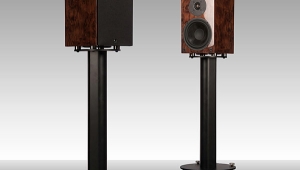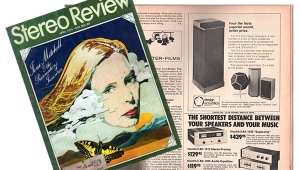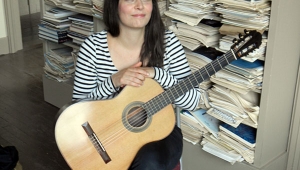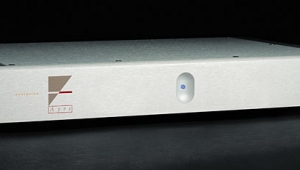| Columns Retired Columns & Blogs |
The Fifth Element #80 Page 2
I think that, following some years of doldrums in the US, Unison and Opera will have a higher profile going forward. After 20 years as president of cable company Cardas Audio, Colleen Cardas left to form, with Marc Phillips, Colleen Cardas Imports, at just about the time that Unison and Opera were looking for new representation for the US. Cardas already had a long relationship with Unison and Opera from those brands' often having used Cardas cables while developing and demonstrating their products.
I got in touch with Colleen Cardas because I wanted to put together a system, based on Parasound's excellent CD 1 player (see my June column), that would be the other end of the tonal spectrum from the combination of the Canalis Anima speakers and the AVM Inspiration C8 CD receiver that I wrote about in February. Not that there was anything wrong with the Canalis-AVM system. The Canalis Anima, a descendant of the Audio Physic Step, puts a premium on clarity and articulation. And of course, given the size of its woofer and cabinet, it has limited bass extension. The AVM Inspiration C8, also a German design, is a solid-state unit that puts a premium on speed. I wanted to hear how Parasound's CD 1 would fare connected to components that were tonally more like Châteauneuf-du-Pape than New Zealand Sauvignon Blanc.
Colleen Cardas urged me to listen to the S6, a 35Wpc, class-A stereo integrated amplifier ($4895), which she thinks occupies the sweet spot in Unison's tube line in terms of price vs performance. After two unfortunate events of shipping damage, and the need to swap out a weak ECC82 input tube from the amp that arrived undamaged, I settled down to a listening experience that was eerily similar to that of 10 years ago: I switched the thing on and got a whomping big dose of music.
Unison Research has its own industrial design style for its tube amps. The S6 is deeper than it is wide: 13.7" (350mm) W by 8.2" (210mm) H by 19.1" (490mm) D. The chassis is longitudinally divided into three portions: a central raised center section that houses the transformers, flanked by identical lower sections that hold the tube sockets, bias meters, and bias adjustment controls. The tubes' bases are surrounded by stainless-steel baseplates or skirts that reflect light and heat. Chrome tube cages, slightly reminiscent of gerbil cages or treadmills, are provided. These would be a practical necessity if you have toddlers, but I think the S6 looks more inviting without.
The front panel has a central On/Off switch, a sensor for the remote control, a source selection knob for five single-ended line inputs (no phono), and a volume knob, all set off by wooden trim rings. Volume is controlled by the remote control, but not the source control or on/off. The rear panel provides two pairs of sturdy insulated speaker terminals, an IEC power inlet, and five pairs of input jacks plus tape outputs.
Setup involved removing the tube cages, inserting the input and power tubes, reinstalling the tube cages, and making the connections. The tube-biasing provisions are the easiest I've used. After warm-up, you hold down the button for each of the tubes and turn the associated knob until the needle in the bias meter centers. Unison claims that its biasing is a combination of manual and automatic; I assume that this means that the meter is for rough adjustment, and that the automatic circuit provides fine adjustment.
I think that a major contributing factor to the S6's robust yet refined sound is the size and weight of its transformers. This is a very heavy amp—about 55 lbs—and I'm sure that the extra iron in its transformer cores helps it sound more like 55Wpc than 35. The S6 performed flawlessly, though it did throw off a lot of heat.
The S6's circuit design is intriguing. Each channel uses three EL34 power pentode tubes in a class-A, single-ended, triple-parallel configuration. Seeing three power tubes per channel looked strange for a while, given that I'm more used to push-pull designs. I got over it.
Perhaps a better comparison for the S6 than the S2K would be Ars-Sonum's excellent Filarmon°a SE, which I wrote about in October 2007. Of course, I'm relying on auditory memory. But I think that while auditory memory may be fleeting, memories of one's reactions do hold up. The S6, unsurprisingly, given its much greater weight and higher price, is a more forceful amplifier, but gives up nothing in finesse, this despite the fact that its rated power output is only 5W greater than the Filarmonia SE's.
 Opera Callas loudspeaker
Opera Callas loudspeaker
Colleen Cardas just as strongly urged me to try the Callas loudspeaker from Opera Loudspeakers (whose products she also distributes in the US), which she claimed was an ideal match for the Unison S6. In my experience, the stand-mounted Callas ($5000/pair) is unique among loudspeakers in being the logical contrapositive (inverted and flipped, so to speak) of the usual D'Appolito driver array of midrange-tweeter-midrange (MTM).
In the well-known D'Appolito array, one tweeter is partnered with two midrange drivers, one each above and below it. Opera's two-way Callas has one vertically centered 5" mid/woofer with a copper phase plug, and identical 1" soft-dome tweeters above and below it. As if that weren't enough, on the narrow rear panel are three more tweeters, identical to those in front, in a vertical array. The enclosure has two small ports, side by side at the top of the rear panel. The Callas measures 14.8" high by 9" wide by 13.4" deep, its cabinet symmetrically tapering toward the rear, and weighs about 57 lbs. The cabinet is made of elegant solid woods and veneers in a high-gloss finish of medium-shade cherry (except for the recessed, black-painted base plate), with black leather cladding on the faceted fascia. There's a small brass badge on the base plate. Front grilles are provided, but I didn't use them. A single pair of robust, naked (non–Euro-Nanny) speaker terminals is at the bottom rear. Opera claims for the Callas a frequency range of 32Hz–25kHz, sensitivity of 86dB, and a nominal impedance of 4 ohms. The mid/woofer and front tweeters are crossed over at "around 1500Hz," the rear tweeters at 2000Hz.
I placed the Callases on 24"-high stands about 5' apart, 2' from the front wall, and toed in to face my listening position, about 8' from each speaker, and toward the nearfield side of midfield listening.
After hooking up the Callases, I braced myself to be bombarded with five times as much treble as normal, even with a tube amp like the Unison S6 that was a bit on the rich side. My fears were totally unfounded. The Callas was very well-behaved, with a genuinely sweet disposition. That just goes to show that a name is not always an omen. (Diva Maria Callas was reportedly a bit of a handful on her bad days.) After quite a bit of listening to the Callas-S6 combination with Parasound's CD 1, via Cardas Clear interconnects and speaker cables, I came to some strongly held conclusions.
First, this is just a great system, ready for you to pack up and take home—a true get-off-the-audio-merry-go-round system. Colleen Cardas was right: the S6 and Callas are hugely synergistic.
Second, I was pleasantly surprised by both the dynamic capability and the bass extension of the Callas-S6 combo. Unlike with many two-way speakers, I never got the sense during most normal listening (as distinct from playing very loud to impress myself or friends) that there was "almost" enough bass—there really was enough bass.
Third, as expected, the Callas-S6 combination was the timbral polar opposite of the Canalis-AVM system. The latter led with information from the treble, the Callas-S6 with tones from the midrange.
The Callas-S6 combo delivered a sound that was, first of all, widescreen. I think the rear tweeters produced a wider soundstage than conventional speakers (there was no way to turn the rear tweeters off), in a way reminiscent of most Shahinian speakers. There was never a sense of too much treble unless the recording itself was too hot; the treble and midrange were very well integrated. In addition to being widescreen, the sound was a bit soft-focus, but by no means grainy. Last, tonalities were a bit on the Technicolor side, but always addictively enjoyable.
In addition to the recordings mentioned above and in my last column, the most frequent flyer of which was Aaron Diehl's The Bespoke Man's Narrative (CD, Mack Avenue MCD 1066), I spent a lot of time with a new set of old works by Arthur Bliss (5 CDs, EMI Classics 29018); a wonderful set of symphonies and orchestral works by Franz Berwald, performed by Roy Goodman and the Swedish Radio Symphony Orchestra and engineered by Tony Faulkner (2 CDs, Hyperion Dyad 22043); Iona Brown and Josef Suk's underrated recording of Mozart's Sinfonia Concertante with the Academy of St Martin-in-the-Fields (CD, Argo/Decca 411 613); Lucia Popp's radiant disc of Mozart opera arias (CD, EMI Classics 09679); David Oistrakh's recording of Brahms's Violin Concerto with Otto Klemperer and the French National Radio Orchestra (CD, EMI Classics 74724), which sounded better than ever through the CD-1–S6–Callas system; Mahler's Symphony 3 with Glen Cortese conducting the Manhattan School of Music Orchestra (2 CDs, Titanic), which did not make the system cry "Uncle"; and, to change things up, Procol Harum's In Concert with the Edmonton Symphony Orchestra (A&M/Mobile Fidelity Sound Lab) and L. Subramaniam's Electric Modes (2 CDs, Water Lily Acoustics WLA-ES-4&5-CD).
It's funny that, 10 years ago, while reviewing Unison's S2K, one of the speakers I listened to was the late, lamented ASA Pro Monitor, a two-way stand-mount from France that I and a few others (including Sam Tellig) found offered a musical trueness very difficult to describe. The Pro Monitor's recipe was simple: an Esotec rather than an Esotar tweeter, a Dynaudio 6.5" mid/woofer with a magnesium basket, a double-walled cabinet clad in ¾"-thick exotic hardwoods, and a simple crossover with premium parts. Perhaps the real secret, though, was that all of ASA's design decisions, such as using the less swank of Dynaudio's available high-end tweeters, were claimed to have been arrived at by listening. By the time ASA threw in the towel, the US price of the Pro Monitor had risen to $5000/pair.
Opera claims on its website that "every single aspect of the [Callas] design was subjected to intense musical listening tests at Opera." I can believe it—the Callas sounds like that kind of a speaker. So if you regret having missed the ASA Pro Monitor, here's that rare thing in life: a second chance. And the price hasn't even gone up.
To sum up the Unison Research S6: totally fatigue-free, with surprising dynamics and bass; a Class A integrated amplifier.
To sum up the Opera Callas: luscious midrange, sweet treble, large soundstage, surprising bass, eminently listenable; Class B (Restricted Extreme Low Frequencies).
- Log in or register to post comments




































